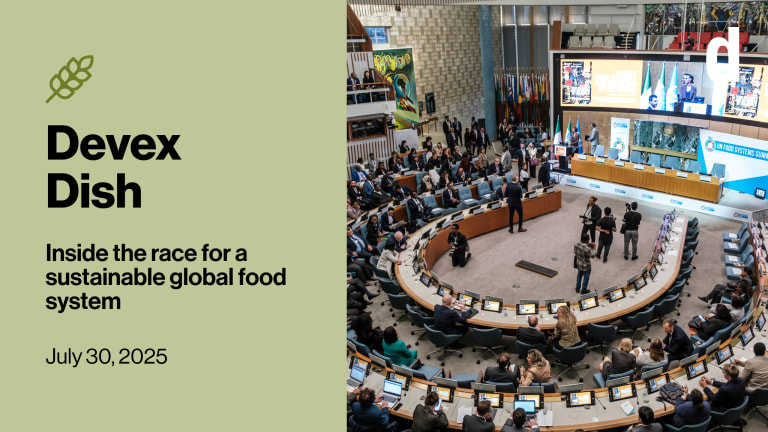
The United Nations Food and Agriculture Organization has urged countries to make their agri-food systems more able to withstand sudden shocks and stresses after the disruptions experienced due to the COVID-19 pandemic.
Get the inside track on how agriculture, nutrition, sustainability, and more are intersecting to remake the global food system in this weekly newsletter.
In the organization's latest State of Food and Agriculture report, published Tuesday, FAO emphasized that the pandemic’s impact on livelihoods was a wake-up call to address weaknesses in agri-food systems, and that the resilience of such systems must be a priority.
According to the report, even before COVID-19 broke out, the world was not on track to meet its commitment to end hunger and malnutrition by 2030. Food production and supply chains have historically been vulnerable to climate extremes, armed conflicts, or increases in global food prices — and the frequency and severity of such shocks are on the rise.
“Resilience refers to a set of characteristics that allow agri-food systems to sustainably ensure availability of and access to sufficient safe and nutritious food for all, over time — in the face of any disruption,” said Máximo Torero Cullen, FAO’s chief economist.
Compared to other economic sectors, agriculture is disproportionately exposed and vulnerable to adverse natural hazards. Cullen admitted that the agriculture sector proved relatively hardy during COVID-19, but said that bigger challenges may arise.
Advocates question the COP 26 approach to food systems
Food advocates criticized the conference's overall approach to food systems and questioned whether commitments made will result in real transformation in the absence of a concrete agenda and clear channels to access the financing.
“Nobody really faced a situation where there was no food in their countries. Almost all countries had access to food … COVID-19 only disrupted supply chains at the beginning but the sector adjusted,” he said. “It's good what we were able to do; what the sector was able to do, but … we could be facing stronger shocks.”
FAO director-general Qu Dongyu added that the COVID-19 pandemic “highlighted both the resilience and the weakness of our agri-food systems.”
“The key message of the SOFA is that countries need to have absorptive capacity,” he said.
According to the report, there are approximately 3 billion people who cannot afford a healthy diet but an additional 1 billion people would join their ranks if a shock reduced incomes by one-third. For example, food costs could increase for up to 845 million people if a disruption to critical transport links were to occur.
The report also assessed the ability of countries to respond to or recover readily from shocks and analyzed the absorptive capacity of agri-food systems using a series of indicators linked to four key systems' functions: robust primary production, availability of food, physical access to food, and economic access to food.
While low-income countries generally face more challenges, the report found that middle- and high-income countries are also at risk. High-income countries such as Australia and Canada were found to be at risk from a shock due to the long distances involved in the distribution of food.
“Resilience refers to a set of characteristics that allow agri-food systems to sustainably ensure availability of and access to sufficient safe and nutritious food for all, over time — in the face of any disruption.”
— Máximo Torero Cullen, chief economist, FAO“What the report brings today is a photograph of the situation using the four indicators,” Cullen said. “And our job, together with countries, is to take this photograph and based on that to try to assess what will be the consequences and how we can increase resilience in those different images.”
In order to strengthen resilience, FAO recommended that governments make resilience in agri-food systems a strategic part of their responses to ongoing and future challenges through diversification, connectivity, and enhancing the resilience capacities of vulnerable households.
Diversity — in production, output markets, import sources, and supply chains — was a key resource during the pandemic because it created multiple pathways for absorbing the shock.
The vulnerability of small and medium agri-food enterprises and the resilience capacity of rural households — especially those involved in small-scale agricultural production — were also found to be critical.
The report highlights that government support is needed to enhance the resilience of food supply chains to develop small and medium agri-food enterprises and to support small and medium-scale farmers who struggle to compete for access to processing facilities and capital, said Hubert Hamer, acting chief scientist at the United States Department of Agriculture.
John Hoddinott, a professor of food and nutrition economics and policy at Cornell University, said COVID-19 was not just a supply shock, but also a shock to consumers’ income and to parts of the food system that link producers to consumers, such as storage and distribution.
“The pandemic exposed how much these matter,” he said, “and how little we know about them.”









